The Christmas cactus, scientifically known as Schlumbergera, is a popular houseplant renowned for its vibrant Christmas Cactus blooms during the Christmas season. Unlike traditional cacti, this plant features flat, segmented stems and produces colorful flowers in shades of pink, red, and white, which makes it a festive addition to holiday decor.
Alongside its vibrant growth, it may suffer from Christmas Cactus diseases. One of the most common problems with Christmas Cactus is Christmas Cactus limp and wrinkled. Here, we’ll explore why the leaves on your Christmas Cactus limp and accordingly figure out ways to revive your Christmas Cactus plant. Before bringing your Christmas Cactus back to life, let’s take a quick look at the common problems they may face.
Table of Contents
Common Problems with Christmas Cactus
Christmas cactus is a popular houseplant like Thanksgiving Cactus, also known for its vibrant blooms during the holiday season. Since these breathtaking blooms typically appear during the Christmas holiday season, they are quite appealing to plant enthusiasts. With proper Christmas Cactus care, this tropical plant can bloom for several years and thrive in bright indirect light. However, they can also experience several common Christmas Cactus diseases.
Here are some of the most frequent ones:
- Wilting Christmas Cactus
A wilting Christmas Cactus shows signs of distress with its once-vibrant, flat segments appearing droopy and limp. The leaves may lose their firm, plump texture, causing them to sag downwards rather than maintaining an upright posture. In addition to the drooping appearance, affected leaves might take on a duller shade of green and may even display yellowing or browning at the edges, indicating that the plant is struggling to obtain adequate moisture.
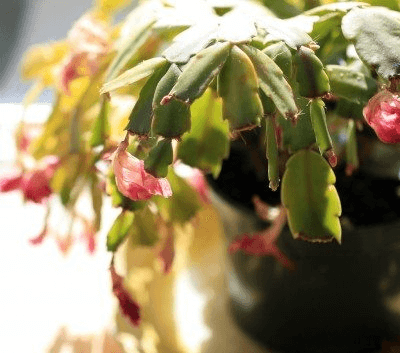
Wilting Christmas Cactus
- Christmas Cactus limp and wrinkled
It presents a concerning sight, with its flat, segmented leaves drooping downwards instead of standing upright, giving the plant a wilted appearance. The normally smooth and plump segments may develop noticeable wrinkles or a shriveled texture, indicating a lack of moisture.
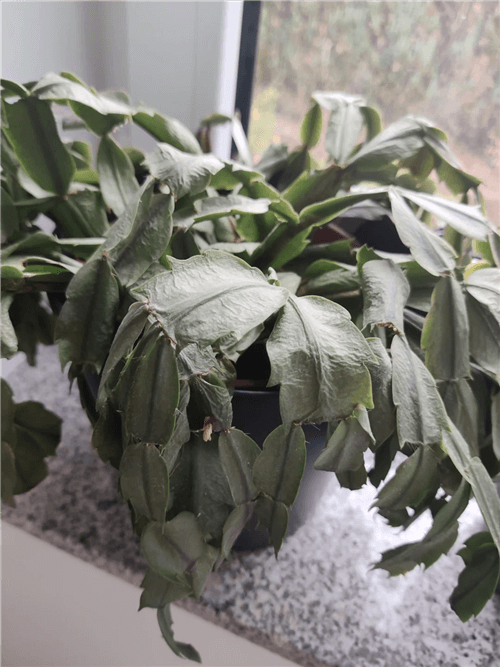
Christmas Cactus Limp and Wrinkled
- Christmas Cactus drooping
When Christmas cactus leaves are falling off, their leaves typically appear as flat, segmented pads that are falling from the main stem.
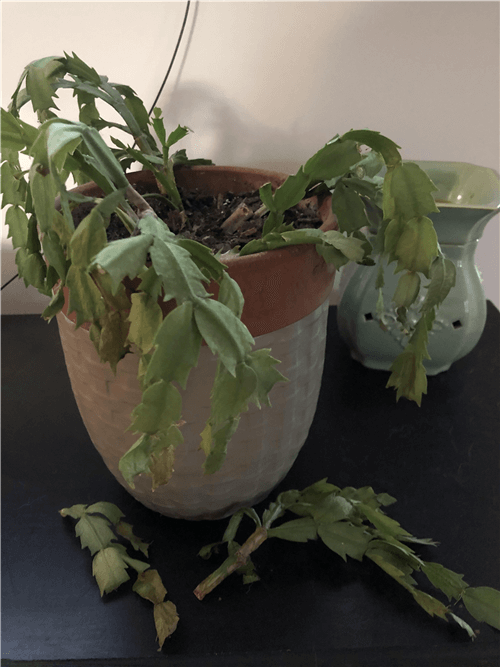
Christmas Cactus Drooping
- Spots on Christmas Cactus leaves
These spots may present as small, discolored patches that contrast with the healthy green of the leaves. They can be brown or black, often appearing sunken or raised, and may result from pest infestations, fungal infections, or environmental stress. In some cases, spots might be yellow or white, indicating a potential issue with overwatering or nutrient deficiencies. The presence of these spots often signifies that the plant is under stress and requires closer inspection
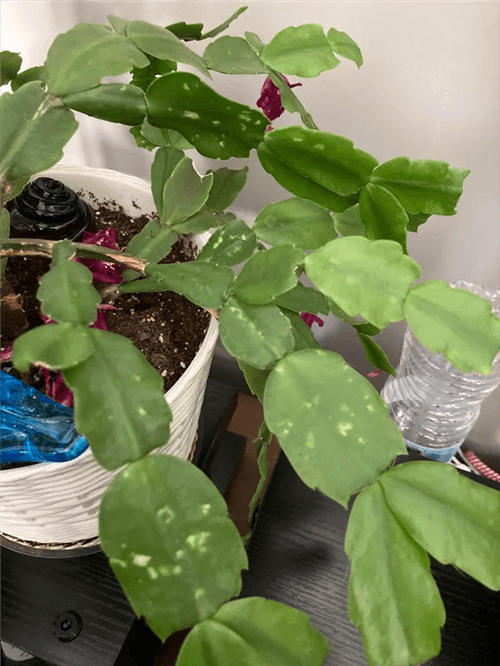
Spots on Christmas Cactus leaves
- Christmas Cactus leaves turning yellow
When the leaves of a Christmas cactus (Schlumbergera) start to turn yellow, they transition from a rich green to a pale, dull yellow, creating a stark contrast that makes the plant appear less vibrant. This yellowing can manifest across individual segments or entire pads, often leading to a lifeless, droopy appearance. Affected leaves may also show signs of wilting or wrinkling, indicating potential dehydration or stress.
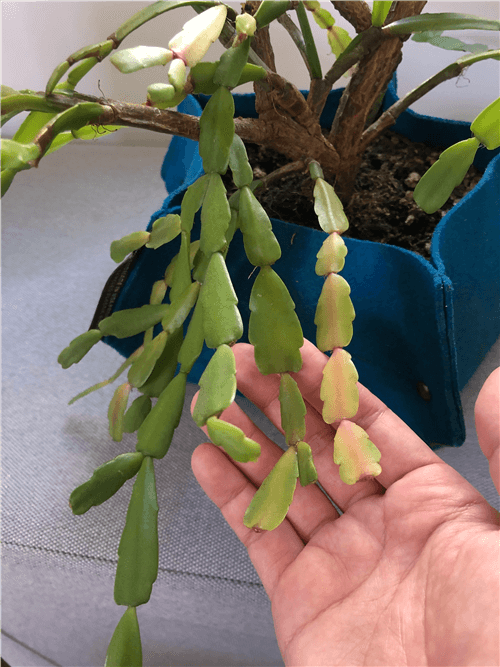
Christmas Cactus Leaves Turning Yellow
- Christmas Cactus leaves turning red
When the leaves of a Christmas cactus (Schlumbergera) begin to turn red, they typically develop a striking reddish hue that contrasts with the plant's usual green color. This reddening can occur on individual segments or across entire pads, often appearing as vibrant patches or a more uniform tone. The red coloration may be accompanied by a slight wilting or curling of the leaves, indicating that the plant might be experiencing stress, such as exposure to too much direct sunlight or temperature fluctuations. In some cases, the red coloration can also signal that the cactus is preparing to bloom, as it may change color in response to environmental cues.
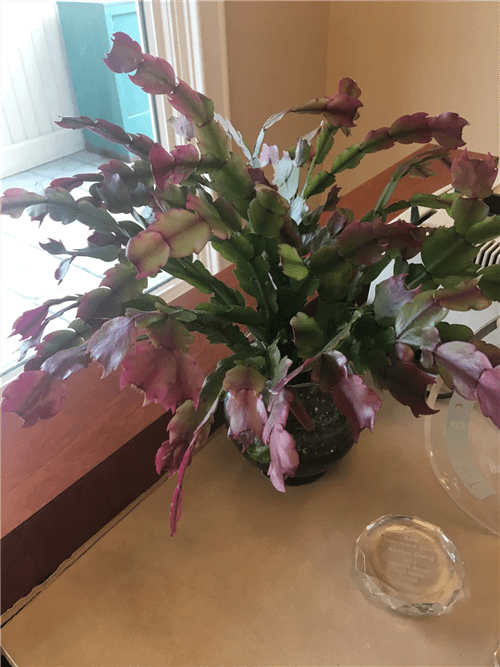
Christmas Cactus Leaves Turning Red
- Christmas Cactus not growing new leaves
When a Christmas cactus (Schlumbergera) is not growing new leaves, it may exhibit a stagnant or sparse appearance, with the existing segments appearing healthy but lacking the vibrant new growth typically seen during its active growing season. The plant may maintain its mature leaves, which are flat and segmented, but there will be a noticeable absence of fresh, youthful pads emerging from the stems. In some cases, the overall plant may look compact and somewhat less lush, as the lack of new growth can make it seem less vibrant. Additionally, the older leaves might start to show signs of aging, such as slight wrinkling or discoloration, as the plant focuses its energy on survival rather than expansion. This stagnation can signal underlying issues such as inadequate light, improper watering, or nutrient deficiencies, prompting a closer examination of the plant's care conditions.
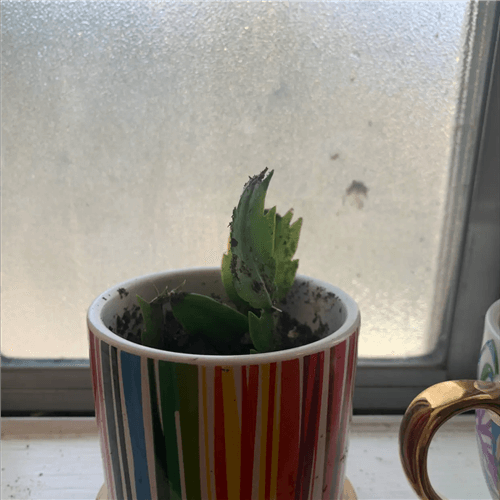
Christmas Cactus Not Growing New Leaves
Why Are the Leaves on My Christmas Cactus Limp or Wilt?
If you’ve noticed the leaves on your Christmas cactus looking limp and lifeless, don’t feel worried. You’re not the only one to face this situation as this is a common concern among Christmas Cactus fans. Limp leaves can be a sign that your cactus is experiencing stress, often due to improper care. Identifying the underlying cause is crucial for restoring your Christmas cactus to its former glory. Here, let’s take a closer look at why the leaves on your Christmas Cactus are limping or wilting. These factors can also explain why your Christmas Cactus are dropping leaves.
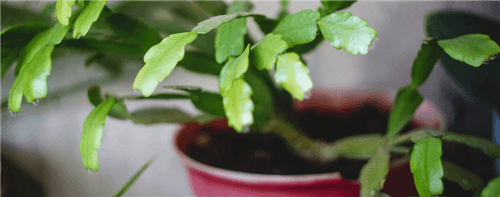
Why Are the Leaves on My Christmas Cactus Limp?
- Inadequate Light: Inadequate light can significantly lead to limp leaves and discourage your plant's vitality. When the cactus does not receive enough bright, indirect sunlight, it struggles to photosynthesize effectively, resulting in weakened growth and reduced energy levels. In consequence, the leaves may become limp and droopy, lacking the firmness and plumpness typical of a healthy plant. Additionally, inadequate light can hinder the development of new leaves and blooms, making the overall appearance of the cactus less vibrant. Over time, this lack of adequate light not only causes the leaves to lose their rigidity but can also leave the plant more susceptible to diseases and pests, further exacerbating the limpness and overall decline in health. To ensure your Christmas cactus thrives, it's essential to make it receive sufficient indirect sunlight or place it under an LED grow light throughout the day.
- Overwatering: Overwatering Christmas Cactus can lead to root rot and deprive the plant of essential nutrients. On the other hand, underwatering can also cause the leaves to lose their firmness. In this case, the cactus will struggle to retain moisture.
- Temperature Fluctuations: Temperature fluctuations can have a detrimental effect on your Christmas cactus, causing its leaves to become limp and lifeless. This plant thrives in stable conditions, ideally between 60-70°F (15-21°C). When it is exposed to sudden changes in temperature — whether from drafts, heat sources, or moving between warm and cold environments — it can cause significant stress, leading to wilting and drooping leaves.
- Pest Infestations: Pest infestations can severely impact the health of your Christmas cactus, leading to limp leaves that signal distress. Common pests such as mealybugs, spider mites, and aphids can latch onto the plant, feeding on its sap and nutrients. This feeding action not only weakens the plant, causing it to lose vigor, but it can also result in visible symptoms like yellowing leaves, webbing, or sticky residue known as honeydew. As the plant struggles to cope with the infestation, its leaves may become limp and droopy, lacking the firmness typical of a healthy cactus.
How to Revive a Christmas Cactus Plant?
If your Christmas cactus is looking less vibrant than usual, don’t despair! These resilient plants can often bounce back with the right care. As Christmas cactus can become stressed due to improper watering, lighting, environmental stress, or pest infections, you can easily identify the signs of distress and find effective ways to revive your plant. Also, you can DIY a Cactus Christmas Tree to ensure you can enjoy its striking flowers year after year.
In this section, we’ll explore effective strategies to bring your Christmas cactus back to life, ensuring it thrives during Christmas day.
- Improve Lighting: Move the cactus to a spot with bright, indirect sunlight and avoid direct sunlight. You can also use LED grow lights to supplement light when you need to;
2025 Spider Farmer SF300 33W LED Grow Light For Seedling Indoor Garden
In stock
Buy 2 Get Extra 8% 2025 Newest Version Spider Farmer SF600 74W LED Grow Light Hydroponics Grow Indoor Flower Garden
In stock
2025 Spider Farmer® SF600 growshelves Indoor led grow light and Metal Plant Stand with Plant Trays
In stock
2 Pack Spider Farmer SF300 33W LED Grow Light For Seedling Veg Flower
In stock
Spider Farmer® Glow80 80W LED Grow Light Bars – Full Spectrum, Waterproof, Linkable Lamps for Indoor Plants, Cloning, Veg & Bloom
In stock
2025 Spider Farmer 4 Tier Plant Stand With Grow Lights 54W , Plant Shelf with Grow Tent for Clone Seedling Indoor Plant, Cloning and Greenhouse
In stock
Spider Farmer® 3Bars Glow80 80W LED Grow Light And Metal Plant Stand with Plant Trays
In stock
2025 Spider Farmer SmartG12 Hydroponic Gardening System Kit,APP & Wifi Controlled,36W LED Grow Light,12 Pods Indoor Herb Garden,6L Water Tank
In stock
Spider Farmer 4 Tier Plant Stand With Grow Lights 54W With Plant Shelf for Clone Seedling Indoor Plant and Greenhouse,4 pcs Seed Starter Trays,
In stock
2025 Newest Version Spider Farmer 4 Tier Plant Stand With Grow Lights 108W , Plant Shelf with 1680D Grow Tent for Clone Seedling Indoor Plant and Greenhouse
In stock
Flash Sale I 2025 Newest Version Spider Farmer 6 Tier Plant Stand With Grow Lights 220W , Plant Shelf with 1680D Grow Tent for Clone Seedling Indoor Plant and Greenhouse
In stock
Spider Farmer Glow80 80W LED Grow Light, Full Spectrum Waterproof, Linkable Plant Lamp for Seedling, Veg, Flower & Hydroponic with GGS AC5 Power Strip Kit
In stock
- Assess Watering Needs: Check the soil moisture. If it’s dry, give the plant a thorough watering, ensuring excess water drains out. If the soil is soggy, allow it to dry out before watering again.
- Check Humidity: Christmas cacti prefer higher humidity. Consider misting the plant or placing it on a humidity tray to help with recovery.
- Avoid Fertilizers: Hold off on fertilizing until the plant shows signs of recovery, as this can stress it further.
- Trim Damaged Parts: If any segments are severely wilted or shriveled, prune them off with clean scissors to encourage new plant growth.
- Monitor Pests: Check for pests that could be affecting its health. Treat any infestations promptly.
Finally, be patient! It may take time for your Christmas Cactus to recover. It’s important to continue to provide proper care and monitor the plant’s progress.






















































I did a bad thing left in the cold overnight, what is the best step to bring back
Great advice can’t afford the light but will move it to warmer environment
My Christmas cactus is 15 years old and beautiful until lately. He loves the kitchen sun. It is his home. We have had more cold & snow this year so not sure what is wrong with him. He has sections that are wilting and there is powdery white dust around? Odd. Due to his age he is too big to transplant again. Does anyone know the problem or have any other ideas? I am saddened of this find.
Great info. Thanks.
Could it be root bound
Thank you!
Your article on Christmas cacti is helpful and encouraging. My plant is sick (yellowing and dropping some stems) but is blooming. I want to repot it , but hesitate to do that while it is blooming. Every time I pass it I feel guilty. Help.
My plant rarely blooms or has only one or two blossoms. Otheerwisw it seems fine. Help!
I’ve had my Christmas cactus for over 7 years and just in the last year it started dropping whole segments. I’ve got a water meter stick and try not to water it unless it is dry. I’ll keep a better eyebon it to make sure it v is thoroughly drained before replacing it in its holding container. thank you. AB
I have my new 2nd CC. I finally gave my first one away to someone that had experience with them.
I now have a new one that is several weeks old and so far Slavic and ok. I just saw this article and could not wait to read snd learn appropriate methods for caring with my plant. soo I’m all ears information:)
Best information on this plant that I ever read!!
My cactus has been in the shade all summer in very high temperatures in South Carolina. It usually does fine on the deck but maybe it’s gotten to old to stand the heat. I’ll bring it indoors after watering it and misting it again.
I guess I’ll bring it indoors when it starts getting 80- 90 plus degrees. Thanks for your article!